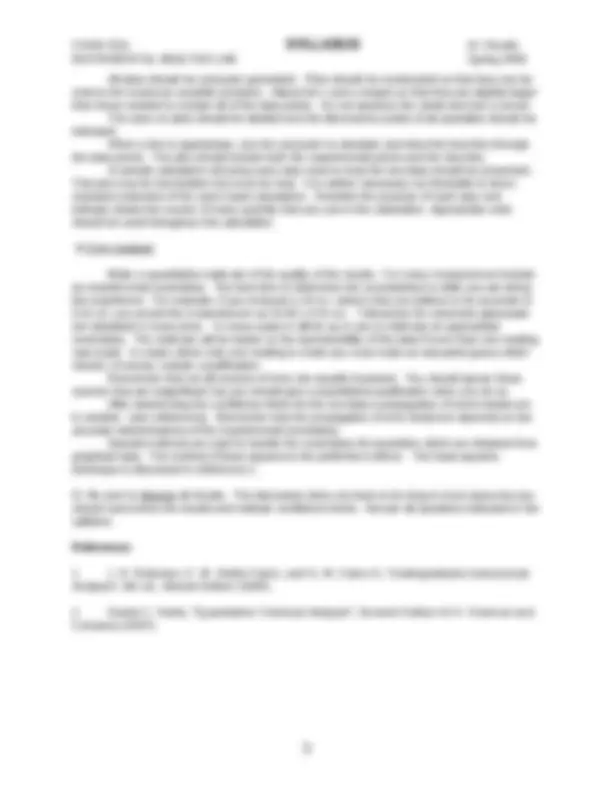



Study with the several resources on Docsity

Earn points by helping other students or get them with a premium plan


Prepare for your exams
Study with the several resources on Docsity

Earn points to download
Earn points by helping other students or get them with a premium plan
Community
Ask the community for help and clear up your study doubts
Discover the best universities in your country according to Docsity users
Free resources
Download our free guides on studying techniques, anxiety management strategies, and thesis advice from Docsity tutors
The syllabus for a one-credit laboratory course, chem 322l, taught by dr. Dilella during spring 2008. The course focuses on instrumental analysis, providing hands-on experience using modern analytical instrumentation and techniques. Students learn how to prepare samples and operate several types of instruments, including atomic spectroscopy, molecular spectroscopy, electrochemistry, mass spectroscopy, and chromatography. Students are expected to use advanced data handling and error treatment methods, and personal computers are available for data analyses. Topics covered also include safety procedures and lab report requirements.
Typology: Lab Reports
1 / 3

This page cannot be seen from the preview
Don't miss anything!


INSTRUMENTAL ANALYSIS LAB Spring 2008 DESCRIPTION CHEM 322L is a one-credit laboratory course that provides hands-on experience using modern analytical instrumentation and techniques. Students learn how to prepare samples for and how to operate several types of instruments. Topics covered include atomic spectroscopy, molecular spectroscopy, electrochemistry, mass spectroscopy and chromatography. Students are introduced to and are expected to use advanced data handling and error treatment methods. Personal computers are available for use in data analyses. Students are expected to use a computer spreadsheet program for data analysis and presentation. TEXT Lab Manual is available in the bookstore OFFICE HOURS MWF 10-11, 3-4 R 1-2 or by appointment Byrd Center 113 304-876-5430 ddilella@shepherd.edu web page: http://WEBPAGES.SHEPHERD.EDU/DDILELLA/ CLASS HOURS R 2:10 - 5: PREREQUISITES CHEM 209, 209L are required. CHEM 321 and CHEM 321L are strongly recommended. CHEM 322 should be taken concurrently Computer skills are not a prerequisite but students who do not know how to do basic computer spreadsheet operations should see the instructor as soon as possible to get special tutoring in these skills. With the aid of a computer spreadsheet program, the time required to do the lab reports will be significantly reduced. SAFETY The experiments have been designed with safety as a major consideration. If everything went as planned there would be little danger. However, the equipment and procedures will be unfamiliar and mistakes can and will occur. Be sure that you understand the hazards associated with the equipment before starting an experiment. Do not be afraid to ask questions. SAFETY GOGGLES MUST BE WORN AT ALL TIMES. Students may NEVER work in a lab without permission of the instructor or without supervision. PREPARATION BEFORE THE LABORATORY You will be able to work much more efficiently in the lab if you understand what it is you are trying to do. READ THE TEXT BEFORE THE EXPERIMENT. Figure out how to prepare the solutions before coming to lab so you don't waste valuable lab time. Be prepared. The time spent in preparation is time that you won't have to spend in the lab.
INSTRUMENTAL ANALYSIS LAB Spring 2008 LAB NOTEBOOK All data should be entered in a bound lab notebook. Spiral bound notebooks are not acceptable. The lab notebook should include all information that was not known before the experiment. Each page should include the date and the name of the experiment. All entries should be clearly labeled and should have correct units. All measurements should include estimated uncertainties. Your notebook should be signed by the instructor at the end of each lab period. FINAL GRADE The final grade will be based solely on the lab reports. There will be no tests or quizzes. The final grade will be based on the following scale A 90 % to 100 % B 80 % to 89+ % C 70 % to 79+ % D 60 % to 69+ % LAB REPORTS Each lab report will be graded on a scale from 0 to 100. Reports are due one week after the completion of the experimental work. Two points will be deducted from the score for every day that the report is late. A lab report is required for each lab. The charts and tables in lab reports must be computer generated. The major part of most reports should be done using a computer spreadsheet program. Discussion and answers to questions may be handwritten if they are neat. Reports should include the following information.
The experimental uncertainties of the data should be included with each data entry. All tables should have titles. The units of all tabulated data should be listed in the table.